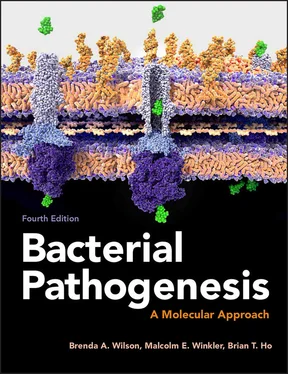Pronovost P, Needham D, Berenholtz S, Sinopoli D, Chu H, Cosgrove S, Sexton B, Hyzy R, Welsh R, Roth G, Bander J, Kepros J, Goeschel C. 2006. An intervention to decrease catheter-related bloodstream infections in the ICU. N Engl J Med 355:2725–2732. [PubMed] [CrossRef]
Salemi C, Canola MT, Eck EK. 2002. Hand washing and physicians: how to get them together. Infect Control Hosp Epidemiol 23:32–35. [PubMed] [CrossRef]
Servin AL. 2004. Antagonistic activities of lactobacilli and bifidobacteria against microbial pathogens. FEMS Microbiol Rev 28:405–440. [PubMed] [CrossRef]
Strober W. 2006. Immunology. Unraveling gut inflammation. Science 313:1052–1054. [Review of an article in the same issue of the journal.] [PubMed] [CrossRef]
Toke O. 2005. Antimicrobial peptides: new candidates in the fight against bacterial infections. Biopolymers 80:717–735. [PubMed] [CrossRef]
Winslow EH, Jacobson AF. 2000. Can a fashion statement harm the patient? Long and artificial nails may cause nosocomial infections. Am J Nurs 100:63–65. [PubMed]
Questions
1. In what sense are S. epidermidis infections an example of how changing human practices can provide new opportunities for bacterial pathogens? S. epidermidis is classified as an opportunist. Why is this the case?
2. Explain why infections of the skin occur more often in folds of the skin or under bandages than in regions of skin exposed to air.
3. How and why do the defenses of mucosal surfaces differ from those of the skin? How do they resemble each other?
4. Consider a bacterium that is ingested via contaminated water and locally colonizes the small intestine. What host defenses would hamper this type of colonization from occurring initially and from leading to an infection in an unimmunized person?
5. Resident microbiota are essential in preventing the colonization of pathogenic bacteria in certain parts of the body. Name the regions of the body where normal microbiota might be protective. Name some mechanisms by which they accomplish this protection. Name some organs that normally remain sterile to bacterial contamination and that do not contain a resident microbiota.
6. Why are people with indwelling catheters more susceptible to infection?
7. Explain the role that mucin plays in host defense.
8. Lysozyme is more effective against growing bacteria. Why might that be so? Why is lysozyme digestion often more effective against Gram-positive bacteria than Gram-negative bacteria?
3
IN THIS CHAPTER
Triggering Innate Immune Defenses
Innate Immune Cells That Defend Blood and Tissue
Neutrophils (PMNs)
Monocytes, Macrophages, and Dendritic Cells (DCs)
Granulocytes: Basophils, Mast Cells, and Eosinophils
Transmigration—How Do Phagocytes Know When and Where to Go?
Natural Killer (NK) Cells
The Lymphatic System
How Phagocytes Recognize and Respond to Bacteria
How Phagocytes Kill Bacteria
Oxidative Burst in Phagolysosomes
Autophagy—Another Pathway for the Killing of Intracellular Pathogens
The Complement Cascade
Complement Proteins
Overview of Complement Pathways and Their Function
Steps in Complement Activation
Controlling Complement Activation
Cytokines and Chemokines—Mediators of Immune Responses
Roles of Cytokines and Chemokines in Directing Innate Immune Responses
Inflammation and Collateral Damage
Septic Shock: The Dark Side of the Innate Defenses
Other Innate Defenses of the Body—Nutritional Immunity
Selected Readings
Questions
CHAPTER 3
The Innate Immune System
ALWAYS ON GUARD
Bacterial invaders can enter the blood and tissue at any time due to breaches in skin or mucosal surfaces. When this happens, the body needs a way to react quickly and in a relatively nonspecific way to those invaders, regardless of whether it has encountered them before. At the same time, the body must also have a way to distinguish the invading cells from its own cells, and cells that have been infected from those that have not. How would you design a “barcode” for bacteria? Even scientists with advanced degrees might be stumped by that question, but that is precisely what the human body has done using the cells of its immune system. The innate immune system jumps into action when the skin or mucosal barriers are breached, but it does so in a carefully controlled way—which is a good thing, because overreaction by this same defense system can cause considerable damage to the host. Finally, to ensure that all invaders are cleared from the body and that an even faster and more specific response is mounted at the next attempted invasion by that pathogen, the innate immune system prompts and primes the adaptive immune system.
Triggering Innate Immune Defenses
Skin and mucosal surfaces are highly effective in preventing pathogenic bacteria from entering the tissue and blood, but from time to time bacteria succeed in breaching these surfaces. We ended the previous chapter with a brief mention of the skin- and mucosal-associated lymphoid tissue (SALT and MALT, respectively) defense systems located at the interface between the external surface defenses and the underlying tissues and blood. When the skin and epithelial layers are breached, both SALT and MALT have critical functions in stimulating additional defenses, initially triggering the general innate immune system and then priming the more specific adaptive immune system. MALT activation also keeps microbes away from the vulnerable epithelial layer by producing secretory immunoglobulin A (sIgA) that binds to both mucin and the microbe and is then sloughed off and removed from the body. We will return to this aspect of MALT in chapter 4.
The most important function of the innate immune system is to quickly recognize and eliminate pathogens. The innate immune system is comprised of a subset of white blood cells (leukocytes) that include phagocytic cells (phagocytes), granulocytic cells (granulocytes), and natural killer (NK) cells. Because these cells are always present and ready to respond, they are the body’s first responders to pathogen invasion. Together they help clear foreign elements from the body and process them for presentation to the adaptive immune system. The innate immune system becomes activated when it recognizes components of foreign invaders. For bacteria, this recognition is through shared repeated structural components and other molecules specifically found in bacteria. These quasi “bacterial barcodes” are termed pathogen-associated molecular patterns (PAMPs) and play an important role in initiating the innate immune responses by triggering the production and release of cytokines and chemokines from infected cells and from nearby immune cells. Additional proteins and peptides found in the circulatory system, collectively referred to as the complement system, help organize and regulate the activities of the phagocytes, NK cells, and other immune cells. Along with phagocytes and NK cells, the components of the PAMP recognition system and complement system are key players in detecting invaders and triggering the innate and adaptive immune responses (major players are listed in Table 3-1).
Table 3-1. Components of the innate immune system and their activities

Innate Immune Cells That Defend Blood and Tissue
The major cell types comprising the innate immune system can be grouped into three categories based on their primary modes of action: phagocytes, granulocytes, and NK cells. Phagocytes are cells that ingest and kill foreign invaders. Granulocytes (basophils, mast cells, and eosinophils) promote the killing of invading pathogens by releasing proinflammatory cytokines and stimulating immune cells. NK cells are cytotoxic cells that act extracellularly to attack and kill host cells that are infected with bacteria or altered due to interaction with bacteria or their products. The characteristics of different phagocytes, granulocytes, and NK cells, as well as their relationships to each other and to cells of the adaptive immune defense system, are illustrated in Figure 3-1. We will begin our discussion with the phagocytes, which include polymorphonuclear leukocytes (also called PMNs or neutrophils—we will use these two terms interchangeably), monocytes, macrophages, and dendritic cells (DCs).
Читать дальше













